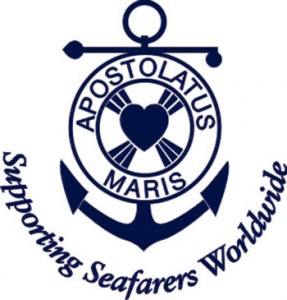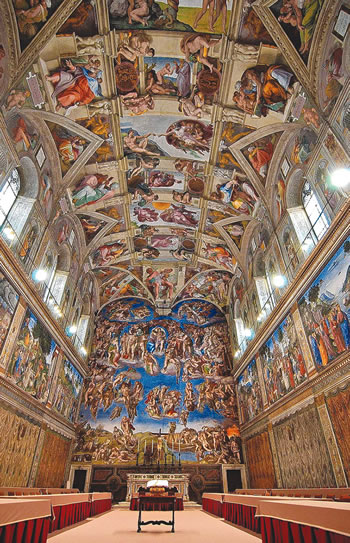Seafarers, Sistine Chapel
The Care of Seafarers - VIS 8 Nov

 “The Year of Faith present a challenge to the chaplains and volunteers of the Apostleship of the Sea who will meet at this congress in order to seek adequate pastoral responses to the problems faced by seafarers”. Among these problems, Cardinal Veglio identified the use of modern time-saving technological innovations which, while improving the speed and ease of work at sea, do not always bring corresponding improvements to the lives of seafarers, especially “those who accept employment contracts requiring them to spend many months living away from their families”. In recent years this problem has been compounded by “the abandonment of ships and their crews in foreign ports without food or resources, and under increasingly restrictive measures that forbid seafarers from coming to land and expose them to abuse and exploitation. … Another issue is that of piracy, which causes long-term psychological trauma not only to seafarers but also to their families”. Many international organisations consider fishing to be one of the most dangerous professions in the world. Moreover, aside from regulated work, we must not ignore the phenomenon of illegal, unreported and unregulated fishing which is not infrequently connected to human trafficking and forced labour”
“The Year of Faith present a challenge to the chaplains and volunteers of the Apostleship of the Sea who will meet at this congress in order to seek adequate pastoral responses to the problems faced by seafarers”. Among these problems, Cardinal Veglio identified the use of modern time-saving technological innovations which, while improving the speed and ease of work at sea, do not always bring corresponding improvements to the lives of seafarers, especially “those who accept employment contracts requiring them to spend many months living away from their families”. In recent years this problem has been compounded by “the abandonment of ships and their crews in foreign ports without food or resources, and under increasingly restrictive measures that forbid seafarers from coming to land and expose them to abuse and exploitation. … Another issue is that of piracy, which causes long-term psychological trauma not only to seafarers but also to their families”. Many international organisations consider fishing to be one of the most dangerous professions in the world. Moreover, aside from regulated work, we must not ignore the phenomenon of illegal, unreported and unregulated fishing which is not infrequently connected to human trafficking and forced labour”
Sistine Chapel: Story of Light & Salvation
On Nov 5 Benedict XVI presided at the first Vespers of the Solemnity of All Saints in the Sistine Chapel. The ceremony was intended to repeat a gesture of Pope Julius II who, on this day in 1512, inaugurated the chapel following the completion of the ceiling decoration by Michelangelo.
“Why”, the Pope asked, “are we recalling this artistic-historical event with a liturgical celebration? Firstly, because the Sistine Chapel is, by its nature, a place of liturgy, the ‘Cappella magna’ of the Vatican Apostolic Palace. Furthermore, because the works of art that decorate it, especially the cycle of frescoes, find in the liturgy their living environment, the context in which they best express all their beauty, their richness and their fullness of meaning. … In brief, the Sistine Chapel, contemplated in prayer, becomes even more beautiful, more authentic; it is revealed in all its richness”.
Referring to Giorgio Vasari, who defined the Sistine Chapel as the light of art that illuminates the world, the Pope noted that “the light comes not only from the skilful use of colour, or from the movement that animates Michelangelo’s masterpiece, but from the idea that permeates the great vault: it is the light of God which illuminates these frescoes, and indeed the entire chapel; … that light whose power conquers chaos and obscurity, bringing light through creation and redemption. The Sistine Chapel narrates this story of light, of liberation, of salvation; it speaks of God’s relationship with humanity.
“With Michelangelo’s work of genius, our gaze is drawn to the message of the Prophets, to the pagan Sybils awaiting Christ, and finally to the origin of all: ‘In the beginning God created Heaven and Earth’. With a unique expressive intensity, the great artist depicted God the Creator, His action, His power, to show that the world is not the product of obscurity, of chance or of the absurd, but that it derives from intelligence, freedom and from a supreme act of love. In that encounter between the hand of God and the hand of Adam, we perceive the contact between heaven and earth; in Adam God enters into a new relationship with His creation, and man is in direct contact with God, is called by Him, and is the image and likeness of God.
“To pray this evening in the Sistine Chapel, enveloped in the history of God’s journey with man, admirably represented in the frescoes above and around us, is an invitation to worship”, concluded the Holy Father.
Tagged as: liturgy, ministry to seafarers, Pope, Sistine Chapel
Comments are closed.
 Entries(RSS)
Entries(RSS)